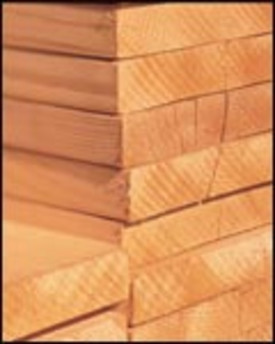The Environmental Protection Agency and the leading companies in the wood-preservative industry have come to an agreement to end the residential use and sale of all wood products treated with CCA (Chromated Copper Arsenate) as of January of 2004. CCA is the dominant chemical used to pressure-treat wood and preserve it from decay and rot. It is CCA that has traditionally protected wood against termites and fungus, and kept decks standing for years and years. But CCA contains arsenic, a known carcinogen. Given that it is present in so many residential items, from decks and picnic tables to railings and playsets, the consensus is to pull it out of circulation in residential construction. "The phase-out is a voluntary decision made by the manufacturers," states Rob Koethe of the EPA’s Region I Office. "Arsenic is a known human carcinogen, and any reduction in public exposure is a step in the right direction."
Pressure Treated Wood is Everywhere
The market for pressure-treated wood is massive. Millions of cubic feet of wood products are pressure treated, purchased, and installed every year. When wood is pressure treated, chemical preservatives like CCA are driven deep into the cellular structure of the wood. This makes the wood inedible for termites and other insects, and resistant to fungi, dry rot, and decay. Pressure-treated wood can last up to 40 years, making it an obvious choice for decks, porches, playgrounds, and other structures. CCA has been the leading preservative used in the United States for more than 50 years. By 2004, however, CCA-treated wood products will be strictly limited to use in marine pilings, telephone poles, and other select non-residential structures.
Devising Safer Alternatives
 |
||||
|
||||
The three big wood-preservative manufacturers—Arch Wood Protection, Chemical Specialties, and Osmose—have been hard at work making the transition from CCA products to alternative, arsenic-free products. This new generation of preservatives—which includes Alkaline Copper Quartenary (ACQ) and Copper Azole (CBA)—makes use of organic copper-based formulas. ACQ is the more-widely used alternative in the United States. Although labeled a new generation product, ACQ has been used successfully as a pressure treatment for more than 10 years. "These new-generation products are just as effective as the CCA-products," says Mel Pine of the American Wood Preservers Institution. "They have been subjected to the same testing as CCA-treated wood, and all contain registered pesticides." Pine insists that little will change for the consumer in terms of product and availability. "To the average do-it-yourselfer, nothing has really changed," he says. "He [still] goes to the retailer and buys treated wood. For all intents and purposes, most people won’t notice the difference."
Of course, there are alternatives to treated wood. Denser woods such as redwood, cedar, and mahogany are all used in the same manner as pressure-treated wood. Although typically more expensive, many homeowners prefer the appearance of these untreated woods. Most will also last as long as their pressure-treated counterparts. Composite decking is another viable alternative to pressure-treated wood (see sidebar). This "plastic wood" never needs sealing or staining, and is impervious to insects, rot, and all of other enemies of natural wood.
The Cost to Consumers
One thing is certain: While the market adjusts, consumers can expect to pay more for pressure-treated alternatives. Right now, ACQ-treated wood sells for anywhere from 15-70 percent more than CCA-treated wood. James Langeway of Gregory Supply Building Center in Burlington, Vermont, sees the price of ACQ-treated wood falling in the near future. "CCA-treated wood is still a big item out there. But once the treatment mills are fully on-line and treating with ACQ, the suppliers can carry more of it, and the price will drop." For now, the CCA-treated 12-foot deck boards at Gregory Supply list for $5.12. ACQ-treated deck boards list for $8.86. There’s no doubt that the cost adds up for the total project. "These alternative preservatives are made from more expensive organic components, so the final product is slightly more expensive" explains Pine.
Existing Structures
This decision by manufactures to phase out the use of CCA-treated wood for residential structures has many people asking what to do with existing structures made from pressure-treated wood. The EPA does not suggest tearing down any structure made of CCA-treated wood. Many feel that applying coatings and sealants to the wood might minimize any chance of exposure to arsenic, although this is a topic of some debate. "There is very little data on the subject of sealants and their effectiveness against arsenic risk," states Koethe of the EPA. "We suggest taking commonsense precautions, especially when it comes to children. That means washing your hands after playing on structures and keeping food from direct contact."
Credit: Renovate Your World




























